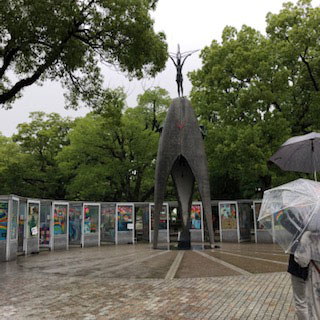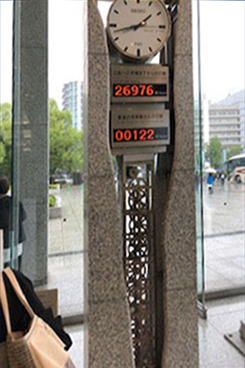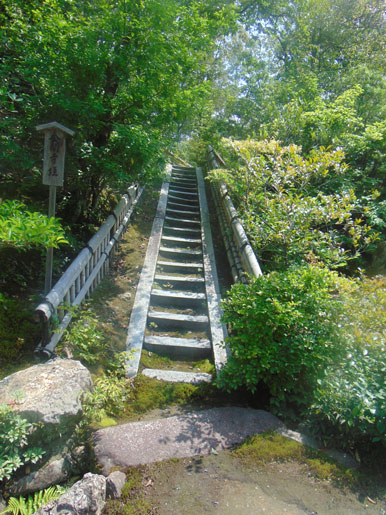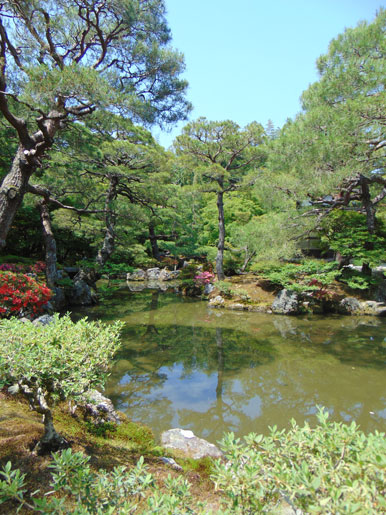Sisters reflect on their journey in Japan
Interculturality, the interaction of people from different cultural backgrounds, is a very important aspect of living as a School Sister of Notre Dame (SSND). The congregation is spread throughout the world, so sisters experience different cultures during their lifetime. Two sisters reflect on their experiences when going to Japan.
My Japanese experience
By Sister Mary Warner, Ph.D.
I decided to experience Japan through the Japanese Language Program. This program was established by SSND in an effort to provide intensive English courses for students in Kyoto. Among the most powerful experiences of the program for me was the trip to Hiroshima. Sister Judith Kamada, the Shalom representative for Japan, provided an orientation before the trip and shared a very powerful video called The Back Destiny. The video portrays the terrible burns a man suffered in the bombing; he initially refused to allow the United States news request to photograph his horribly scarred back, thinking of them only as part of the aggressors who dropped the bomb. His wife pleaded for him to let the news take the photos so the world could know of the incredible suffering. The man ultimately agreed, but as his story continued, it shows the long-term pain and loss of normalcy that the Atomic bomb (A-bomb) wreaked on Japan.
I was woefully unaware of some of the harshest realities of the bombing, including that the majority of those who died first were children ages 12 to 13. These children were out demolishing buildings to create a fire break in the face of relentless bombing. Children were the only ones not already in the war effort.

The Children’s Memorial at Hiroshima, featuring a young girl holding a crane in her outstretched arms, appears almost like a cross, and is particularly poignant. Herein lies the conflict for me. I have never been in a country where I am considered the “aggressor.” Yes, the Japanese bombed Pearl Harbor without warning; yes, my dad was in the Pacific Theatre in WWII; yes, many Americans died at the hands of the Japanese. But now I was learning and seeing firsthand, the horrors of the U.S. military’s A-bomb. I was accompanied by Sister Judith who had been 4-years-old at the time. In the case of Nagasaki, a plutonium bomb was dropped. I sensed a bit of what the German School Sisters of Notre Dame must have felt during WWI and WWII; torn by love of my homeland and guilt in the face of multiple images of what my country did.

Very strikingly, Hiroshima’s museum and memorial are called the Peace Memorial. In the U.S., the memorials are all war memorials. In the same vein, another powerful image at Hiroshima was the clock image. Immediately below the clock showing the time, is a counter giving the number of days since the dropping of the A-bomb. When I was there on June 15, 2019, the number was 26,976. Below this counter is another that gives the number of days since the last nuclear test, that number was 122. Who knows how many nuclear tests have plagued the world since June 15, 2019? As I spoke with the women at Kyoto Notre Dame (ND) University about my impressions of Japan, I returned often to my experience at the Peace Memorial. My thoughts centered on the impelling reality of our global community; we only have so much air and so much water; we share this small world. If weapons of destruction like the A-bomb could wreak so much destruction in 1945, what might the weapons of 2019 and 2020 cause? The destruction will not be limited to a small part of some country, we have to become a global community working together to use every peaceful means possible.
At all three of the SSND schools in Japan – Kyoto ND University, Notre Dame Junior High and High School and Notre Dame Elementary – Japanese SSND have worked hard to make Mother Theresa visible. Each institution has a chapel, images of Mother Theresa and at Kyoto ND University, there is a “sisters’ lounge” right across from the chapel, where each day one of the sisters volunteers to be available to any women who might want to come to talk with them. In a country where fewer than five percent are Christian, each of the SSND institutions quietly, but clearly, display symbols of Catholicism, exhibiting deep respect for the rich religious traditions of Japan. The temples and shrines, many Buddhist, are sites displaying longstanding spiritual traditions. The wonderful Japanese gardens offer places of prayer and contemplation. The tea ceremony I experienced with several of the Japanese SSND celebrates many core cultural and spiritual values.
I am not the same person I was before my experience in the Japanese Language Program. I hope people will choose to participate in an opportunity to learn more about another part of the world. While I personally found it challenging to be at liturgies, which were all in Japanese, it was truly a gift to unite with the sisters in singing the Marian Anthem at evening prayer.
To learn more about our sisters in Japan, read Sister Ruth Mori’s reflection on Hiroshima, Searching for acceptance.
Just be; my time in Japan
By Sister Linda Marie Bos
Have you ever read about a place and wondered what it really was like? Frequently, I have taught a course about Modern Japan based on what I have read in history books. It left me wondering what it was actually like in that country. I have read the stories of what it was like for the sisters who came from Germany to America. Even though there were many people from Germany here in the United States, this “new” world was very different. How much more different was Japan for Mother Theresa’s vision? Were there parts that easily translated into a non-European culture? Last summer, I had the opportunity to visit Japan with my fellow sisters.
After the flight and a train ride with the principal of the high school in Kyoto, I arrived at Imakaido-cho, one of the SSND communities in Kyoto. The sisters were most welcoming. It was the beginning of a wonderful journey to see SSND in a different culture.
I loved the beginning of the day. We prayed the Office (morning and evening prayer) together, though I listened more to the sisters than participated. On some days there was a Mass; both were in Japanese. I did not understand the words but the body language of the sisters spoke volumes. The reverence in their faces, the stillness in the times of silence, spoke of their presence with the Lord. It was a most comfortable stillness. I realized that I came from a culture that was “busy” and this was different. I often thought of what it was like for the first SSND who came to Japan from post WWII United States, a very noisy and busy place. I thought of how much the Japanese had in common with Mother Theresa. How she would spend time in the presence of the Eucharist, time of stillness. The sisters in Japan understood Mother Theresa’s concept of time, what seemed to be the lens of their culture.
The meals were an extension of Morning Prayer. There was the sharing of You Are Sent, the SSND Constitution. Thankfully, they had an English copy for me. Then we shared in conversations. Meals were a great time to share wonderful stories about the lives of those seated around the table. There was laughter, especially as I tried to use chop sticks or when I was surprised to see Sister Antoinette sitting in the traditional way, her legs folded under her, as she sat on a chair. It was a wonderful experience.
Their days were spent serving the needs of people in the community. SSND worked in various educational institutions and places that cared for the elderly or immigrants. In schools, I expected that this meant teaching. It did, but they had an added dimension. For example, at the University there is a “sister’s room.” It was a place where young women could come for a quiet place. They could eat lunch, work on assignments, or just be. There was a sister present, but there were no expectations. It was not a meeting, nor was it a scheduled activity. If someone wanted to talk, they could, but it was not expected. I thought of places where I taught and how the students’ lives were so heavily scheduled. If they came to a room, there was an expectation and an objective to the visit. But in the “sister’s room,” the young women could find the type of stillness they needed.

On one day, Sister Christine and I spent an afternoon looking for an adaptor for my computer. What was fun was walking the streets and just talking about what we saw. While we were in the metro, it was fascinating to see the young students who were very much at ease. They were not afraid of their surroundings.I loved walking with Sisters Maureen, Gloria and Janet through the historic places and again, I noticed that these were very peaceful and respectful places. I thought of our historic places and how commercialized they are.
Sister Maureen and the director of the English Language Program took us on a tour of the Kyoto Notre Dame University campus before we began the discussion of the language program. The students were open and respectful, but again, I noticed that there was space for them to just be without them having to go to a different building. The space was where the students were.

While getting off a bus after a visit to a Buddhist temple, I had a fall that required me to be hospitalized for a couple days. The sisters were most gracious. They helped me to understand the medical culture of Japan. The sisters helped in every way they could. I was impressed by the doctors, nurses and the entire medical system. Again, I noticed that there was space where the patients could go to just be. From there, I was able to look out at the mountains that surrounded Kyoto. I watched the mist evaporate as the sun rose. The sisters explained the mountains protected the residents of the city from storms. I believe that the mountains also protected the sisters from the constant rush of today’s world. This in turn taught me more of Mother Theresa and the importance of finding space in the rush of the day. It called me to stand in awe of the world that surrounds us. Often, we talk of interculturality, and what we can learn from others; the sisters in Japan taught me to be still and know that God is there.